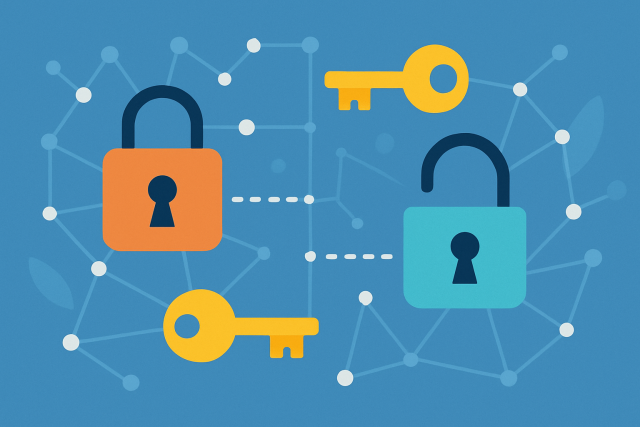Symmetrical Encryption Explained Simply


Symmetrical encryption quietly works behind the scenes to protect your sensitive information every single day, even though its inner workings can seem a little like magic at first glance. This article unpacks symmetrical encryption by exploring how one secret key manages the neat trick of both locking and unlocking your data, why it’s often the go-to choice for speedy and reliable communication.
So, What’s the Deal with Symmetrical Encryption?
Symmetrical encryption keeps your information under wraps by using the very same secret key to both lock and unlock the data. The sender and receiver have to be perfectly synced with that exact key for the conversation to remain airtight.
Imagine a diary locked up tight with just one key that both locks and unlocks it. Only the lucky soul holding that key gets to peek inside or jot down their thoughts. Symmetrical encryption runs along similar lines, where a single key holds the reins to accessing all the secret stuff contained within.
- Just one secret key does the heavy lifting for both encryption and decryption, which keeps everything nice and straightforward.
- Symmetrical encryption usually runs faster than most other methods, making it a solid pick when you’re dealing with large piles of data.
- It’s commonly trusted for bulk encryption tasks, like locking down files or safeguarding communications.
- Making sure that secret key gets shared and managed securely between parties is absolutely key to keep things safe and sound.
Understanding Symmetrical Encryption and Its Basics
Symmetrical encryption is pretty straightforward once you get the hang of it. You start with something everyone can read, called plaintext. Then the sender uses a secret key—think of it like a magical password—to scramble this into ciphertext, which looks like a jumbled mess to anyone else. After that, the receiver flips the process by using the very same secret key to unlock the scrambled text and reveal the original message.
Before any communication kicks off both the sender and receiver are on the same page agreeing on a single secret key.
The sender takes this key and works its magic to turn the plain readable message into scrambled ciphertext.
This scrambled encrypted message then makes its way down the communication channel.
When it arrives the receiver uses that very same secret key to unlock and transform the ciphertext back into the original message.
With a bit of relief the receiver can securely read the recovered message exactly as it was meant to be.
Imagine you want to send the simple message "HELLO" with a secret key tucked under your arm. Symmetrical encryption jumbles that message into complete gobbledygook before it hits the network, like locking your words in a tiny digital safe. On the other end the receiver pulls out the same key and unlocks the safe. Voilà—there’s "HELLO," just as you originally sent it plain as day.
Frequently Used Algorithms in Symmetrical Encryption The Go-To Classics
A handful of well-known algorithms have made symmetrical encryption practical and reliable. Take AES or Advanced Encryption Standard for example—it's the go-to choice these days because it strikes a balance between robust security and decent speed. Then there is DES, short for Data Encryption Standard, which used to be the star but has since been sidelined due to its outdated nature and weaker security. Blowfish still hangs around the ring offering a good blend of speed and security that some people appreciate.
| Algorithm | Typical Key Size | Speed | Common Use Cases | Security Level |
|---|---|---|---|---|
| AES | 128, 192, 256 bits | Fast | Encrypting files, SSL/TLS sessions, VPNs — pretty much the go-to for strong security | Very high |
| DES | 56 bits | Moderate | Found mostly in older systems or where security is not the prime concern anymore | Low (deprecated) |
| Blowfish | 32–448 bits | Fast | Popular in embedded systems and some VPNs, still holding its own in certain corners | Moderate to high |
| 3DES | 112 or 168 bits | Slower | Still lurking in financial systems and legacy apps, though it is showing its age | Moderate |
AES has earned its stripes as the global go-to standard since it strikes a pretty neat balance between robust security and smooth, efficient performance.
Pros and Cons of Symmetrical Encryption
Let's dive into the good, the bad, and the slightly tricky aspects of symmetrical encryption.
- Symmetrical encryption zips through data pretty quickly, making it a solid choice when you’re dealing with large files or streaming data nonstop.
- It leans on simpler algorithms compared to its asymmetrical cousin, which means it usually sips rather than guzzles computing power.
- This method has been around the block and is trusted across tons of industries and use cases.
- Using just one key for both locking and unlocking means things generally move along faster, saving you some precious time.
- Safely passing the secret key between parties can feel like walking a tightrope and is often the Achilles’ heel here.
- If that secret key ends up in the wrong hands, all the data wrapped up with it is suddenly in hot water.
- For open networks, it’s usually not the top pick since securely exchanging keys often calls for extra layers of protection— nobody wants a surprise guest at that party.
Many individuals tend to throw shade at symmetrical encryption thinking it is insecure by default. But honestly, its security really comes down to how the keys are managed.
Managing encryption keys is a bit like handing over your house key to a trusted friend— it stays safe as long as you really trust who’s holding it and keep a good eye on how you share it around.
Symmetrical vs Asymmetrical Encryption and Their Real Difference
Asymmetrical encryption leans on a dynamic duo of keys a public key for locking data up tight and a private key for unlocking it unlike symmetrical encryption, which keeps things simple with just one key for both locking and unlocking.
- Symmetrical encryption leans on just one key to do its magic whereas asymmetrical encryption works with a matching pair of public and private keys like a two-piece puzzle.
- Symmetrical encryption usually gets the job done faster since it’s crunching simpler calculations—kind of like taking the express lane.
- Asymmetrical encryption often steps in when you need to exchange keys securely or double-check someone’s identity. It plays the role of a trustworthy gatekeeper.
- Symmetrical encryption does require a clever way to share that key without letting it fall into the wrong hands.
- Asymmetrical encryption is more of a resource hog computationally but it makes handing out keys over open networks much less nerve-wracking.
Many systems cleverly blend both types of encryption. Asymmetrical encryption steps in to securely share the secret symmetrical key, which then takes over to handle the heavy lifting of bulk data encryption at a much faster pace.
Practical Applications of Symmetrical Encryption Where It Really Shines
Symmetrical encryption pops up everywhere these days, whether it’s guarding your laptop files or locking down internet chats. Since it’s pretty speedy and doesn’t hog resources, it’s often the trusty sidekick for encrypting loads of data on the fly
- Software that scrambles your files to keep your important documents safe and sound on your computer.
- Encryption used by databases to lock down sensitive company information like a digital vault.
- Symmetrical encryption in SSL/TLS sessions secures the heavy lifting of bulk data after the initial handshake is all set.
- WiFi security protocols such as WPA2 rely on symmetrical encryption to keep your wireless traffic under wraps.
- Disk encryption tools shield entire drives on laptops and mobile devices because sometimes you want peace of mind that goes all the way to the disk.
These applications hum quietly in the background and let everyday users browse the web, send messages and keep sensitive information safe.
Tips for Maintaining Security in Symmetrical Encryption
Keeping your symmetrical encryption secure isn’t just about following a recipe—it’s more like tending a delicate garden. Here are some handy tips to help you protect your data without breaking a sweat.
Symmetrical encryption security really hinges on managing keys the right way. It’s vital to create strong and truly random keys, stash them somewhere safe and only pass them along through trusted channels.
Always create strong random secret keys using reliable cryptographic tools because if your keys are weak you might as well leave the door wide open.
Share keys only through secure channels like encrypted messaging apps or trusted physical handoffs. No slipping notes under the digital door please.
Keep key access tight to make sure only the right people or systems get to use them—no freeloaders allowed.
Stick to a regular key rotation schedule to swap out keys before they have a chance to go rogue or get exposed.
Whenever you can rely on hardware security modules (HSMs) to handle keys safely since they are like the Fort Knox of cryptographic environments.
Avoid classic blunders like reusing symmetrical encryption keys repeatedly, sending them over unsecured networks or leaving them in plain text for anyone to grab.






